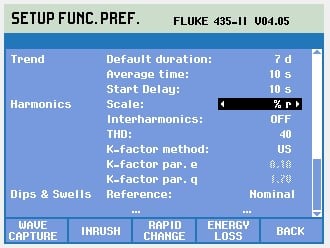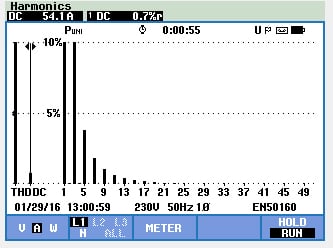Grid connected photovoltaic systems are growing in importance as sustainable energy sources.
The DC power of the solar panels is converted into an AC power by inverters. These are transformerless and, besides generating AC current, also inject a small DC Current. Excessive DC current injection into an AC network can cause problems like transformer saturation, however, which will cause additional losses and reduce transformer lifetime. For measuring these DC components, we need a Power Quality Analyzer which can handle DC voltages and DC currents. The Fluke 430-II series will fulfill this requirement and has this feature which makes this instrument unique for these kind of measurements.
Even small DC voltages can inject large DC currents
The low network impedance of an AC network means that a small DC voltage from the grid connected inverters creates a large DC current injection. This DC current is not a fault current, but is caused by asymmetry between the positive and negative half-wave of the current fed into the grid.
Inverters have no output transformers to block the DC injection, so it must instead be prevented. If DC injection is not prevented at the inverter it will be fed into the network causing issues to components connected to the network.
Even small DC currents can saturate transformers and other electric machines like motors and generators. The effects can show up as noise, vibration, pulsating torque, and overheating.
Many countries already have regulations that protect the network from DC current injections. IEEE Standard 1547.1, IEC61727 and DIN VDE 0126 all specify the maximum DC offset allowed. BS–India, for example, specifies that the maximum allowed DC offset in India is 1 %/2 of the output. See CEA Technical Standards for Connectivity to the Grid, (Amendment), regulations, 2012.
Other sources of DC injection
Modern variable speed drives, especially those with active rectifiers, also inject DC into AC grids.
Other non-linear and non-symmetrical loads like LED lights can inject DC, too. The large-scale use of these components will increase the total injected DC. Offices often have many PCs in use at any one time, which can lead to significant DC current levels.
The exact nature of any summing (or cancellation because of opposite injection polarities) can only be determined by measuring the actual DC injection.
Effect on billing
The DC component will not be recognized by the kWh usage meters. Current and voltage transformers will not pass the DC component to the secondary, so the meter does not see it.
DC components in the load current can come from DC components in the supply voltage driving DC into linear loads, or from using loads drawing (partially) rectified currents. Either way, they saturate the transformer core and cause potentially large registration errors at the meter.
Real-world measurements with a PQ analyzer
A report by the UK’s BSRIA (Building Services Research and Information Association) monitored DC levels in buildings. The measurements were taken by an engineer at BSRIA, using a Fluke 41B power quality analyzer and associated Hall-effect clamp-on current sensors. DC levels of 0.04A (7.7% of rms current) and 0.03A (11.2% of rms current) were identified for individual laptops and desktops respectively.
Fluke has taken similar measurements using a high-resolution Fluke 435-II, which allows you to measure DC currents without using filters. It has DC coupled voltage and current inputs. We used a DC current clamp with a Hall sensor to measure the DC current component.
Harmonics analysis with rms value as reference
The different standards use the rms value as reference for the maximum DC current level, as in the following setup.
Entering the Harmonics menu (Figure 2) and moving the cursor to DC current will give a direct read-out of the absolute and relative DC current values (Figure 3) at the point of coupling of an industrial plant.

Figure 2. DC current measurements on the Fluke 435-II are accessed from the Harmonics menu.

Figure 3: The DC current reading (left) is shown alongside the harmonic values.
Troubleshooting and preventing issues on your network when you are planning to use renewable energy
Reducing the DC current injection will improve the efficiency of transformers and electrical machines. The high resolution DC-coupled Fluke 435-II power quality analyzer measures DC currents without the need for filters or other equipment.